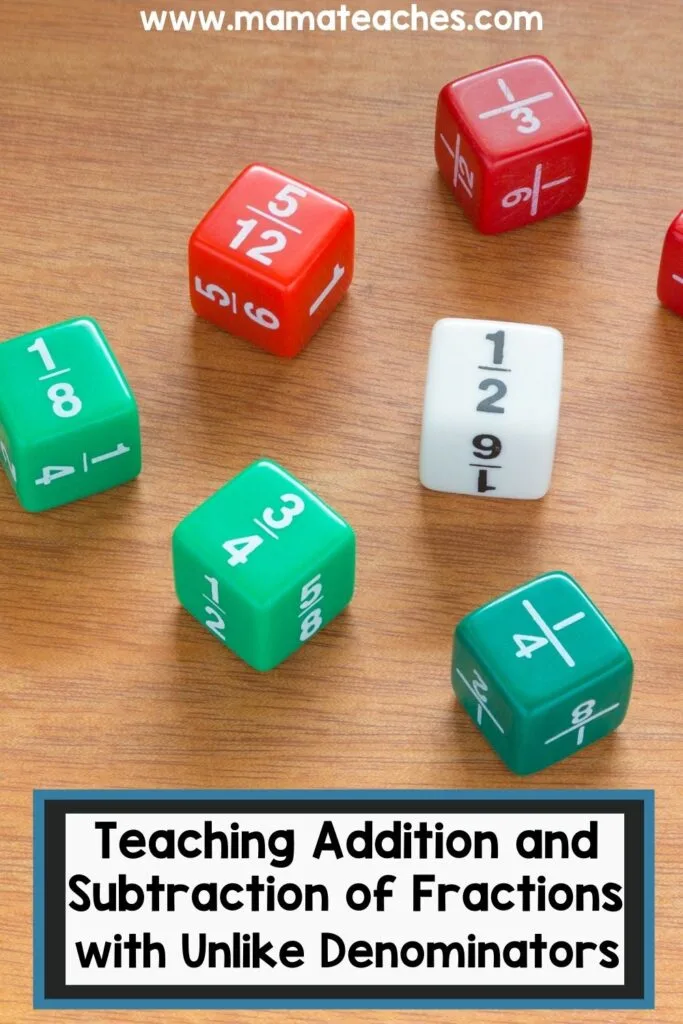This game-changing method will make adding and subtracting fractions with unlike denominators much easier for kids to learn.
Adding and Subtracting Fractions with Unlike Denominators
If you have ever tried to teach addition and subtraction of fractions with unlike denominators, you have probably wanted to hit your head against the wall.
This is a very difficult concept for kids to grasp.
Not only does it involve multiple steps, but it also requires that children understand why they can’t add the numbers straight away.
The why can be difficult to explain.
The good news is that there is a method that will make this concept click.

This article contains affiliate links to things that you might like.
Understanding Equivalent Fractions
Before you begin to teach adding and subtracting fractions with unlike denominators, your students need to understand how to form equivalent fractions.
You will want to use manipulatives to show that fractions can be equivalent: 2/4 is the same as 1/2.
Your students need to be firmly grounded in the skill of making an equivalent fraction.
(You need to multiply or divide the numerator and the denominator by the same number.) 1/2 becomes 2/4 when you multiply the numerator and the denominator by 2.
One equivalent fraction is not larger or smaller than the other; they are equal.
How to Teach Addition and Subtraction of Fractions with Unlike Denominators
When teaching addition and subtraction of fractions with unlike denominators, begin with a demonstration.
You can draw fruit or use real fruit (2 apples and 1 orange).
Say, “Pretend I am an apple seller.
At the end of a day of selling apples, I need to count how many apples I have left in my bins.
I find one apple in the bin on my left, and another apple in the bin on the right.” (Show the apples or draw them on the board.) “How many apples do I have?”
(2) “Exactly. 1 apple plus 1 apple equals 2 apples.”
“The next day I look in my bins to see how many apples I have left. I look in the bin on my left and see 1 apple. I look in the bin on my right, and surprisingly, I see an orange!”
(Show the fruits or draw them on the board.)
“How many apples do I have left? That’s all I care about because I am an apple seller.”
(1) “I have only one apple. Even though I have an orange, I can’t add apples and oranges and get more apples. That just doesn’t work.”

Sorting Fractions by Names
Write four fractions on the board: ¼, ⅚, ⅙, and ¾.
Tell the students that these fractions are like oranges and apples.
How can you tell which ones are which?
You look at the button number, the denominator.
That is the name of the fraction.
There are two fraction names on the board (two denominators): the 4ths and the 6ths.
You can’t add two fractions with different names.
They need to have the same name in order to add them, just like you can only add apples to apples to get more apples.
In order to add fractions with different names, you need to change the name of one or more fractions so they match.
Sample Problem for Adding Fractions with Unlike Denominators
Illustrate this concept by writing down this problem: ½ + ¼ = __.
Point out the two different names of fractions: halves and fourths.
You can’t add these together without changing the names so they are alike.
Since your students already know how to form equivalent fractions, ask them how to change the name of ½ to a fraction with fourths (multiply the numerator and the denominator by 2).
Now that the names of the fractions are matching (2/4 + 1/4), you add the numerators (2+1) and keep the name of the fraction (4).
The answer is ¾.

Addition and Subtraction of Fractions with Unlike Denominators
Remember, your students have limited exposure to terms like numerator and denominator (they hear these words only in the subject of math).
Tie the concept of unlike denominators into something the students already understand (like names and fruits).
This will make all the difference when you teach addition and subtraction of fractions with unlike denominator to kids.
